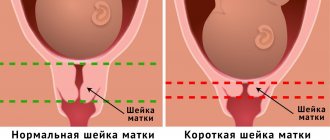Origin
The yolk sac is formed from a special structure - the endoblastic bladder - on the 15-16th day of embryo development (or on the 29-30th day from the last menstruation). During this period, a woman may not yet be aware of her changed status, and only a delay in menstruation indicates a possible conception of a child. The yolk sac develops together with the fertilized egg and other structures of the embryo according to a program given by nature. Any deviations from the genetically programmed rhythm can lead to termination of pregnancy.
The yolk sac is a closed ring located inside the chorionic cavity. It does not function for long - only 12-14 weeks. At the beginning of the second trimester, the yolk sac begins to decrease in size. After 14 weeks, the formation disappears without a trace, having fulfilled all its functions.
Normal indicators by week
The yolk sac constantly grows, increasing in volume along with the fetus and other embryonic structures, from 1.5 to 3 months. The normal sizes are as follows:
- 5-6 weeks (first visualization by ultrasound diagnostics) – 3 mm.
- 6-7 weeks – 3-4 mm.
- 7-8 weeks – 4-4.5 mm.
- 8-9 weeks – 4.5-5 mm.
- 9-10 weeks – 5 mm.
- 10-11 weeks – 5.5 mm.
- 11-12 weeks – 5.5-6 mm.
- 12 week – 6 mm.
Ultrasound examination allows you to reliably determine the size of the pouch. During the first weeks of gestation, the size of the organ changes very intensively, so minimal deviations from the norm (increase, decrease) are acceptable.
Role of the yolk sac
The yolk sac is a temporary (provisional) organ, but without it the normal course of pregnancy and embryo development is impossible. In the early stages, the size of the yolk sac exceeds the size of the embryo and amniotic cavity. The yolk sac actively grows from 6 to 12 weeks of gestation, after which it gradually decreases in size and completely disappears.
On days 18-19 from conception, the yolk sac becomes the focus of hematopoiesis. In its walls, areas of erythropoiesis are formed, and the first red blood cells are formed. Subsequently, a branched network of capillaries is formed here. Primary red blood cells, leaving the yolk sac, enter the circulatory system of the embryo and are carried through the bloodstream throughout the body.
From the 28th day from the moment of conception, the yolk sac begins to produce primary germ cells of the embryo. Subsequently, the germ cells migrate from the yolk sac and reach the gonads (sex glands). 4-5 weeks of pregnancy is an important stage in the development of the fetal reproductive system. Any negative effects during this period (infections, radiation, medication) can disrupt the formation of the gonads of the embryo and cause infertility.
From 2 to 6 weeks of pregnancy, the yolk sac acts as a liver for the embryo. The walls of the yolk sac synthesize important proteins and enzymes necessary for the normal development of the entire organism. In particular, AFP (alpha fetoprotein) is produced here. In the fetal circulatory system, AFP binds to PUFAs (polyunsaturated fatty acids) and transports them to all cells and tissues. AFP also suppresses the immune response to newly synthesized proteins, allowing metabolic processes to proceed at the desired rhythm.
Other functions of the yolk sac:
- regulation of the fetal immune system;
- synthesis of hormones;
- creating conditions for adequate metabolism;
- excretion of metabolic products.
The yolk sac performs all its functions until the main internal organs are formed in the fetal body and take over this work. After 12 weeks there is no need for a yolk sac. By the beginning of the second trimester, only a small cystic formation at the base of the umbilical cord remains from the yolk sac.
Yolk sac on ultrasound
During ultrasound examination with a transvaginal sensor, the yolk sac is detected from 6 to 12 weeks of pregnancy. Minor deviations (up to 2 weeks) in any direction are allowed. The absence of a yolk sac on ultrasound is an unfavorable sign indicating serious problems during pregnancy.
When performing an ultrasound, the doctor evaluates the location, shape and size of the yolk sac. The size of the yolk sac will depend on the gestational age.
Yolk sac norms by week:
It is important to remember: the size of the yolk sac changes rapidly in early pregnancy. Minor deviations should not frighten a pregnant woman and cannot be the basis for making serious diagnoses. If the size of the yolk sac is not normal, the doctor must carefully examine the embryo, determine the location of the fertilized egg and other parameters. If necessary, a repeat ultrasound is performed after 1-2 weeks.
Time frame for ultrasound:
- 6-7 weeks;
- 12-14 weeks.
At 6-7 weeks, the first ultrasound examination during pregnancy is performed. During the procedure, the doctor confirms the fact of pregnancy and determines its duration. The doctor indicates the location of the fertilized egg (in the uterus or outside it), assesses the condition and location of the yolk sac and chorion. The size of the fetus is determined, its correspondence to the gestational age and the size of the yolk sac. At 6 weeks, the embryo's heartbeat is also listened to and its viability is assessed.
At 12-14 weeks, the first ultrasound screening is performed. During the procedure, the doctor evaluates the condition of the embryo, chorion and yolk sac. During this period, the yolk sac reaches its maximum size. When performing an ultrasound at a later date, the yolk sac begins to dissolve and is not always visualized on the screen. After 14 weeks, the yolk sac is normally not detectable.
Adverse symptoms:
- absence of the yolk sac for up to 12 weeks;
- thickening of the yolk sac more than 7 mm or decrease less than 2 mm;
- change in the shape of the yolk sac.
In combination with other symptoms, these conditions may indicate a high risk of miscarriage in the first trimester. To clarify the diagnosis, additional examination using an expert-class device may be required.
Abnormalities during ultrasound examination
On ultrasound, the yolk sac, enlarged to 6 mm, is defined as an oval-shaped body. This parameter is very important for diagnosing and recognizing the normal course of pregnancy.
If the sac is not visualized during examination or is present in a smaller size than normal, then most often the cause of this phenomenon is an incorrect calculation of the gestational age (less than 6 weeks). The absence of a yolk sac after a certain period leads experts to suspect a frozen pregnancy or spontaneous abortion. This suggests that a more in-depth examination using the transvaginal method will be required. Also, the absence of a sac after the 12th week is regarded as normal due to gradual resorption.
Any deviations from normal indicators are always diagnosed in conjunction with other indicators. So, from 4-5 weeks of gestation, the embryo begins to have a slight heartbeat. Therefore, if on the screen of an ultrasound machine the yolk sac is visualized as smaller or larger than normal, then there is no cause for concern; it is necessary to recalculate the period of conception more carefully.
The yolk sac is an embryonic organ that contains a supply of nutrients for the embryo. The yolk sac persists throughout the first trimester and resolves on its own after 12 weeks. The shape and size of the yolk sac are one of the most important indicators of the course of pregnancy in its earliest stages.
Pathology of the yolk sac
When performing an ultrasound, the doctor can detect the following conditions:
The yolk sac is not visualized
Normally, the yolk sac is detected by ultrasound in the period from 6 to 12 weeks. The absence of a yolk sac is an unfavorable sign. If such an important organ is resorbed ahead of time for some reason, the embryo ceases to receive the substances necessary for its development. The synthesis of hormones and enzymes is disrupted, and the production of red blood cells stops. With premature reduction of the yolk sac (before 12 weeks), spontaneous miscarriage occurs. It is not possible to maintain pregnancy with medications.
The absence of a yolk sac on ultrasound (from 6 to 12 weeks) is considered one of the signs of a regressing pregnancy. In this case, the heartbeat of the embryo is not determined, its size does not correspond to the gestational age. Treatment is only surgical. In case of regressing pregnancy, the fertilized egg is removed and the uterine cavity is curetted.
The yolk sac is smaller than normal
Possible options:
- The yolk sac is defined as a rudimentary formation.
- The size of the yolk sac does not correspond to the duration of pregnancy (smaller than normal).
Any of these situations indicates that premature resorption of the yolk sac has begun. If at the time of reduction of the sac the internal organs of the fetus are not yet formed and are not able to fully function, the death of the embryo and spontaneous miscarriage occurs. In some cases, contractions of the uterus and miscarriage do not occur after the death of the embryo. This condition is called regressive pregnancy.
The yolk sac is larger than normal
The main reason for this symptom is incorrect determination of the gestational age. This is possible with an irregular menstrual cycle (against the background of various gynecological pathologies or in nursing mothers). In this situation, the doctor should evaluate the size of the embryo and recalculate the gestational age taking into account the available data.
An important point: changes in the size, shape or density of the yolk sac are important only in combination with other ultrasound indicators. If any abnormalities are detected, the condition of the embryo (location, size, heartbeat) should be assessed. If the baby is growing and developing in accordance with the gestational age, there is no reason to worry. Changes in the yolk sac in this case are considered an individual feature that does not affect the course of the first trimester.
Deviation of the size of the yolk sac from the norm during pregnancy
The parameters of temporary education are sometimes less than normal indicators or, conversely, exceed them. This phenomenon is considered an alarming, but at the same time subjective sign, so it is the doctor’s responsibility to carefully check and decipher it. So, before talking about the presence of any violations, a triple test is carried out. As part of this testing, markers of developmental abnormalities and chromosomal disorders of the embryo are studied.
The same test is relevant when the yolk sac “stayed” in its place for too long. If the presence of any irreversible intrauterine problem is confirmed, the pregnancy is artificially terminated.
The yolk sac is smaller than normal during pregnancy
Too small sizes of the temporary structure indicate progesterone deficiency. The situation can often be corrected with the help of medication. Pregnant women are prescribed Duphaston, Utrozhestan and other progesterone preparations.
In other cases, reduced parameters of the yolk bladder are observed if the organ begins to deteriorate prematurely. At this moment, the vital organs of the fetus have not yet had time to take shape and cannot work normally, so the embryo dies and the pregnancy ends in miscarriage. If spontaneous failure does not occur, the pregnancy is called regressive (frozen).
The yolk sac is larger than normal during pregnancy
When the size of the large yolk sac exceeds the norm, most likely, the gestational age was determined incorrectly, which often happens if a woman cannot boast of a regular monthly cycle. To clarify the situation, the specialist re-evaluates the size of the embryo and recalculates its “age” based on new data.
Note! You can only worry about the qualitative characteristics of the yolk sac, which differ from the norm, if there are other abnormalities detected on ultrasound. If the location of the embryo, its size and heart rate do not cause any complaints from the doctor, all metamorphoses of the yolk sac are perceived as an individual feature of a particular pregnancy, which is in no way reflected in the development of the 1st trimester.
To summarize: if the meeting of the egg and sperm ends in pregnancy, in the absence of critical days, the monitor of the ultrasound machine will display the corpus luteum, and another 6 weeks later the outline of the yolk sac will become visible. If the parameters of this temporary formation do not meet established standards, anomalies of embryonic development in the early stages of pregnancy cannot be ruled out. In this regard, the responsibility of every woman who is preparing to become a mother is to timely register and responsibly follow all doctor’s recommendations.











